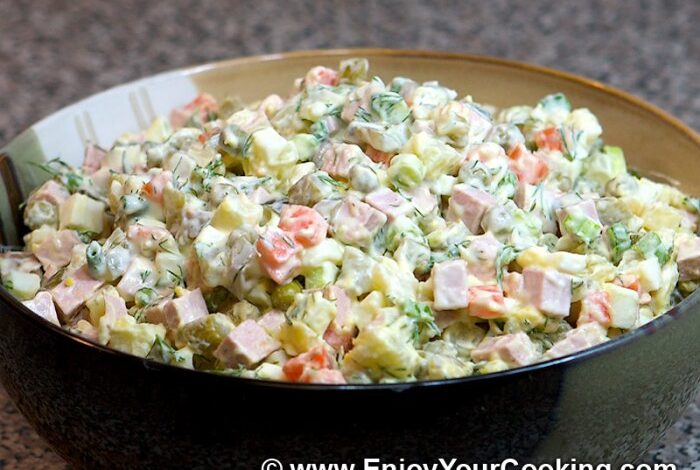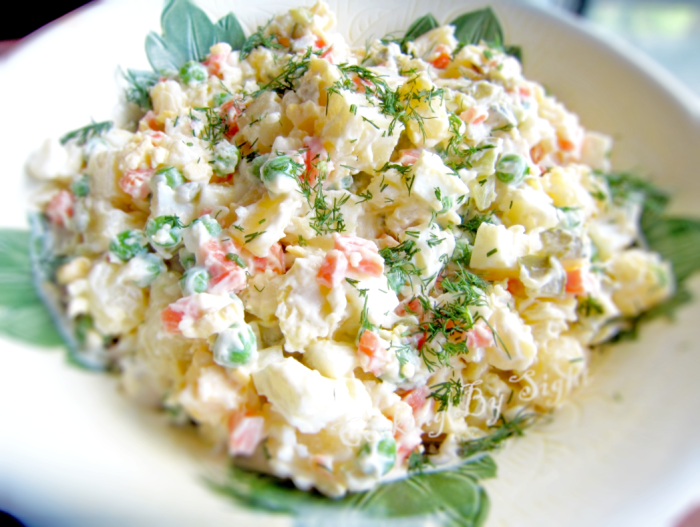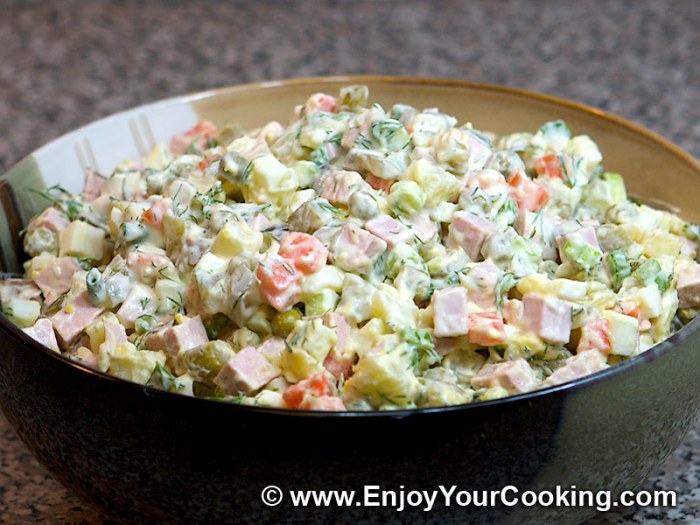
Authentic Russian Salad Olivye: A Culinary Journey
Authentic Russian Salad Olivye, also known as Olivier Salad, is a beloved dish with a rich history and captivating story. This iconic salad, a staple at Russian celebrations, is a vibrant blend of flavors and textures, offering a culinary experience that transcends generations.
Its origins trace back to the 19th century, when it was created by a French chef named Lucien Olivier, who owned a renowned restaurant in Moscow. The salad’s recipe has evolved over time, adapting to local ingredients and preferences, but its essence remains unchanged – a symphony of flavors that embodies Russian culinary traditions.
The traditional Olivier Salad features a medley of ingredients, including boiled potatoes, carrots, and peas, alongside tender pieces of meat or sausage, and a creamy dressing that adds a touch of richness. This symphony of flavors is often enhanced with pickles, onions, and a sprinkle of fresh herbs, creating a dish that is both satisfying and refreshing.
Its cultural significance is deeply ingrained in Russian society, often gracing festive tables during holidays and family gatherings, symbolizing abundance, prosperity, and togetherness.
History and Origin of Olivier Salad: Authentic Russian Salad Olivye
Olivier salad, a beloved Russian dish, has a rich history that spans over a century. Its origins are deeply intertwined with the culinary landscape of 19th-century Moscow and the influence of French cuisine.
The Origins of Olivier Salad
The salad’s name is a tribute to its creator, Lucien Olivier, a renowned chef of French descent. He was the owner and head chef of the renowned Hermitage Restaurant in Moscow, which was known for its elegant ambiance and sophisticated cuisine.
In the 1860s, Olivier introduced a unique salad that quickly became a signature dish of the Hermitage, captivating the palates of Moscow’s elite. The original recipe, unfortunately, remains shrouded in mystery. However, accounts from the time suggest that it was a complex and refined dish, featuring ingredients like game, vegetables, and a special sauce.
The Evolution of Olivier Salad
Over the years, the original Olivier salad recipe has undergone significant transformations. The original recipe, which involved game, was gradually replaced with more readily available ingredients, such as boiled potatoes, carrots, and peas. The sauce, once a secret blend, evolved into a mayonnaise-based dressing.
These changes were influenced by the availability of ingredients, the changing culinary preferences of the Russian people, and the desire to make the salad more accessible.
The Legacy of Olivier Salad, Authentic russian salad olivye
Despite its evolution, Olivier salad remains a cherished dish in Russia and beyond. It is a staple of festive meals, particularly during New Year’s Eve celebrations. Its popularity is attributed to its versatility, its combination of flavors and textures, and its enduring appeal to generations of Russians.
Ingredients and Preparation

Olivier salad, a culinary masterpiece of Russian cuisine, is renowned for its delightful combination of flavors and textures. Its preparation is a testament to the artistry of Russian cooks, with each ingredient playing a crucial role in creating a harmonious and satisfying dish.
Traditional Ingredients
The foundation of Olivier salad lies in its traditional ingredients, carefully selected to create a symphony of tastes. The key components include:
- Potatoes:The base of the salad, providing a creamy and starchy texture. They are typically boiled until tender, then diced into even pieces.
- Carrots:Adding a touch of sweetness and a vibrant orange hue. They are also boiled until tender and then diced.
- Green Peas:Providing a refreshing crunch and a vibrant green color. They are usually canned or frozen, and can be added directly to the salad.
- Pickled Cucumbers:Bringing a tangy and salty flavor, balancing the sweetness of the carrots. They are typically diced into small pieces.
- Meat:Traditionally, boiled beef or chicken was used, but ham or sausage can be substituted. The meat is diced into bite-sized pieces.
- Eggs:Adding a rich and creamy texture. They are boiled hard, then chopped or diced.
- Mayonnaise:The binding element of the salad, creating a creamy and flavorful dressing. It is essential to use a high-quality mayonnaise for the best results.
- Salt and Pepper:Seasoning to taste, enhancing the overall flavor profile.
Preparation Steps
The preparation of Olivier salad is a straightforward process, allowing for a personalized touch. Follow these steps to create a classic Olivier salad:
- Prepare the Vegetables:Wash and peel the potatoes and carrots. Boil them separately in salted water until tender. Drain and let them cool slightly. Dice them into even pieces.
- Cook the Meat:Boil the meat in salted water until tender. Drain and let it cool. Dice the meat into bite-sized pieces.
- Prepare the Eggs:Boil the eggs in salted water for 10 minutes. Drain and let them cool. Peel and chop or dice them.
- Combine the Ingredients:In a large bowl, combine the diced potatoes, carrots, green peas, pickled cucumbers, diced meat, and chopped eggs.
- Season and Dress:Season the salad with salt and pepper to taste. Add mayonnaise to the salad, mixing gently until all ingredients are coated evenly. Do not overmix, as this can result in a mushy salad.
- Chill and Serve:Refrigerate the salad for at least 30 minutes before serving. This allows the flavors to meld and the salad to become chilled. Serve the Olivier salad chilled, garnished with fresh herbs or a sprinkle of paprika for added visual appeal.
Authentic Russian salad olivye is a classic, but sometimes you need a lighter, brighter flavor. That’s where a roasted lemon balm chicken comes in – the herbaceous, citrusy notes of the chicken would be a delicious complement to the potato and pea salad.
And of course, you can always top your olivye with a sprinkle of fresh lemon balm for an extra touch of freshness!
Regional Variations and Adaptations
Olivier salad, despite its standardized recipe, is a dish that has undergone numerous regional variations and adaptations throughout its history. These changes reflect the diverse culinary traditions and preferences of different regions, resulting in a wide array of interpretations of this beloved salad.
Regional Variations in Russia
The most significant variations in Olivier salad can be found within Russia itself. Different regions have developed their own unique twists on the classic recipe, often incorporating locally available ingredients or reflecting local culinary traditions.
Authentic Russian salad olivye, with its creamy potato, carrot, and pea base, is a classic for a reason. It’s hearty, satisfying, and perfect for a potluck or family gathering. For a lighter option, you might pair it with something like Anne’s fabulous grilled salmon , which offers a burst of flavor and healthy protein.
Of course, olivye can also be enjoyed on its own, especially with a dollop of sour cream or mayonnaise.
Variations Based on Ingredients
- In Moscow, the traditional recipe is often adhered to, with the addition of pickled cucumbers and olives being common.
- In St. Petersburg, the salad is sometimes made with a greater proportion of vegetables, such as carrots and peas, and may include the addition of fresh herbs, such as dill or parsley.
- In the Caucasus region, Olivier salad is often prepared with the addition of pomegranate seeds, walnuts, and herbs, adding a touch of sweetness and nuttiness to the dish.
- In Siberia, the salad may include the addition of smoked salmon or other smoked fish, reflecting the region’s strong culinary tradition of using smoked ingredients.
Authentic Russian salad olivye is a comforting classic, a symphony of textures and flavors that brings back memories of childhood. While the creamy potato salad is a perfect centerpiece for a simple dinner, I find it also pairs beautifully with a sweet treat like vanilla coconut flour cupcakes.
The delicate sweetness of the cupcakes cuts through the richness of the salad, creating a delightful balance on the palate. And who knows, maybe the cupcakes will inspire you to try your hand at a new dessert, just as olivye inspires a taste of home.
Variations Based on Preparation Methods
- In some regions, the potatoes and carrots are boiled until very soft and then mashed before being incorporated into the salad, creating a smoother texture.
- In other regions, the ingredients are chopped into smaller pieces, creating a more delicate and refined salad.
Variations Based on Flavor Profiles
- In some regions, the salad is seasoned with a greater amount of salt and pepper, creating a more savory flavor profile.
- In other regions, the salad is seasoned with a touch of sugar, adding a subtle sweetness to the dish.
Adaptations in Other Countries
Olivier salad has also been adapted and incorporated into the cuisines of other countries, particularly in Eastern Europe and Central Asia. These adaptations often reflect the local culinary traditions and preferences of the country in question.
Adaptations Based on Local Ingredients
- In Ukraine, Olivier salad is often prepared with the addition of smoked sausage or ham, reflecting the country’s culinary tradition of using smoked meats.
- In Poland, the salad may include the addition of sauerkraut or pickled mushrooms, adding a touch of acidity and umami to the dish.
- In Germany, the salad is sometimes made with the addition of potato salad, creating a more substantial and hearty dish.
Adaptations Based on Flavor Profiles
- In Hungary, Olivier salad is often seasoned with a touch of paprika, adding a spicy and smoky flavor to the dish.
- In Romania, the salad is sometimes served with a dollop of sour cream or yogurt, adding a tangy and creamy flavor to the dish.
Unique and Creative Adaptations
Beyond regional variations, there are also numerous unique and creative adaptations of Olivier salad that have emerged over the years. These adaptations often reflect the ingenuity of individual chefs and home cooks who have experimented with the classic recipe to create their own unique variations.
Examples of Unique Adaptations
- A vegan version of Olivier salad can be made by replacing the meat with tofu or tempeh, and using plant-based mayonnaise.
- A more modern interpretation of Olivier salad might incorporate ingredients such as avocado, roasted sweet potatoes, or quinoa, adding a touch of contemporary flair to the dish.
- Some chefs have even experimented with incorporating exotic fruits, such as mango or pineapple, into Olivier salad, creating a unique and unexpected flavor combination.
Cultural Significance and Symbolism
Olivier salad, beyond its delectable taste, holds a special place in the hearts and traditions of many cultures, particularly in Russia and former Soviet republics. This beloved dish is not just a culinary creation but a symbol of warmth, togetherness, and celebration.
Olivier Salad’s Role in Celebrations and Family Gatherings
Olivier salad’s association with festive occasions is deeply ingrained in Russian culture. It is a staple at New Year’s Eve feasts, where its vibrant colors and hearty ingredients symbolize abundance and prosperity for the coming year. The salad’s presence on the table also represents a sense of unity and shared joy, bringing families and friends together in celebration.
Its popularity extends beyond New Year’s Eve, as it is frequently served at birthdays, weddings, and other special gatherings.
Symbolism Associated with Olivier Salad
The ingredients of Olivier salad each carry symbolic meaning, contributing to the overall message of abundance and togetherness.
- Potatoes:Representing stability and nourishment, potatoes are a staple food in many cultures, signifying the foundation of a happy and prosperous life.
- Carrots:Often associated with good luck and fortune, carrots add a vibrant touch to the salad, symbolizing a hopeful and bright future.
- Green Peas:Representing growth and renewal, peas symbolize the cyclical nature of life and the promise of new beginnings.
- Pickles:Often seen as a symbol of resilience and adaptability, pickles add a tangy and refreshing contrast to the salad, representing the ability to overcome challenges and thrive in various situations.
- Mayonnaise:Mayonnaise, with its creamy texture and rich flavor, symbolizes unity and togetherness, bringing all the ingredients together in a harmonious blend.
Culinary and Nutritional Aspects

Olivier salad, with its colorful medley of ingredients, offers a delightful culinary experience. However, it’s crucial to understand its nutritional profile to make informed choices about its consumption. This section delves into the nutritional value of Olivier salad, exploring its strengths and weaknesses, and examining the culinary techniques employed in its preparation.
Nutritional Value
Olivier salad, despite its appealing taste, is generally considered a high-calorie dish due to the presence of mayonnaise, potatoes, and other starchy ingredients. However, it also provides a good source of protein, vitamins, and minerals.
- Protein:The meat, eggs, and peas contribute to the protein content, essential for building and repairing tissues.
- Vitamins:The salad contains vitamins like vitamin C from potatoes and carrots, vitamin A from carrots, and vitamin B from eggs and meat.
- Minerals:Olivier salad offers minerals such as potassium, magnesium, and phosphorus, crucial for various bodily functions.
While Olivier salad can be a source of essential nutrients, its high fat content from mayonnaise and the presence of processed ingredients warrant moderation in consumption.
Culinary Techniques
The preparation of Olivier salad involves a series of culinary techniques that contribute to its unique flavor and texture.
- Chopping:The ingredients are finely chopped to create a uniform texture and ensure even distribution of flavors.
- Marinating:The vegetables, often boiled or pickled, are marinated in a vinegar-based brine to enhance their flavor and preserve their freshness.
- Dressing:The salad is dressed with mayonnaise, which acts as an emulsifier, binding the ingredients and adding richness and creaminess.
The skillful application of these techniques results in a balanced and flavorful salad that is both visually appealing and satisfying.
Importance of Fresh and High-Quality Ingredients
The quality of ingredients plays a crucial role in determining the taste and texture of Olivier salad. Using fresh, high-quality ingredients enhances the overall flavor and ensures a satisfying eating experience.
- Fresh Vegetables:Opting for fresh vegetables ensures optimal crispness and a vibrant flavor.
- High-Quality Meat:Using high-quality meat, such as lean beef or chicken, contributes to the protein content and adds a richer flavor.
- Homemade Mayonnaise:Homemade mayonnaise, prepared with fresh eggs and oil, provides a superior flavor and texture compared to store-bought versions.
By prioritizing fresh and high-quality ingredients, you can elevate the culinary experience and create a truly memorable Olivier salad.
Presentation and Serving Suggestions
Olivier salad, a staple of Russian cuisine, is often served in a variety of ways, depending on the occasion and personal preference. The traditional presentation involves a generous portion of the salad, typically piled high in a large bowl or platter.
Traditional Presentation
The salad is usually presented in a bowl, with the ingredients well mixed and layered. It is often garnished with fresh herbs, such as dill, parsley, or chives, and sometimes with pickled cucumbers or olives for a tangy contrast.
Serving Options
Serving Olivier salad can be adapted to suit different occasions and dining preferences. Here is a table outlining various serving options:| Serving Option | Description ||—|—|| Main Course | A large portion of Olivier salad can serve as a hearty and satisfying main course, especially when accompanied by a side of bread or mashed potatoes.
|| Appetizer | A smaller portion of Olivier salad can be served as a refreshing and flavorful appetizer, particularly when presented in individual bowls or on small plates. || Side Dish | Olivier salad can be served as a side dish to accompany a variety of main courses, such as grilled meats, roasted poultry, or fish.
|
Complementary Dishes and Beverages
Olivier salad pairs well with a variety of complementary dishes and beverages, enhancing the overall dining experience. Here are some suggestions:* Beverages:
Vodka
The classic pairing for Olivier salad, vodka’s clean and crisp flavor complements the salad’s rich and savory notes.
Beer
A light lager or a pale ale can also be a good pairing, providing a refreshing contrast to the salad’s richness.
White Wine
A dry white wine, such as Sauvignon Blanc or Pinot Grigio, can complement the salad’s creamy texture and delicate flavors.* Dishes:
Bread
A crusty bread, such as sourdough or rye, can be used to soak up the flavorful dressing and provide a satisfying textural contrast.
Mashed Potatoes
A side of mashed potatoes can add a creamy and comforting element to the meal.
Grilled Meats
Grilled chicken, steak, or pork can be a hearty and flavorful accompaniment to the salad.

